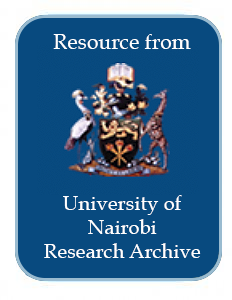Location
Our Vision is to be a world-class university committed to scholarly excellence.
Our Mission is to provide quality university education and training and to embody the aspirations of the Kenyan people and the global community through creation, preservation, integration, transmission and utilization of knowledge.
Core Values
In order to realize the above vision and mission, certain shared values shall be nurtured. There is great need for the University to be guided by the right values derived from the virtues and moral standards of the Kenyan and wider society.
Core Functions
Teaching and Learning: The university offers innovative , relevant and market driven academic programmes , both at undergraduate and postgraduate levels with inbuilt quality control systems the university also provides an environment and policy framework for undertaking high quality and relevant research
Members:
Resources
Displaying 201 - 205 of 298Land Alienation, Land Tenure and Tourism in Maasailand, Kenya
Land is a primary resource for international tourism development. The relationship of indigenous
systems of land tenure, and the history of land alienation to tourism in African nations, however, is
problematic. Governments of some African nations are now emphasizing the traditional land
rights of indigenous people in determining land use for economic development. Land is a key
resource for the local participation of the Kenyan people in development, and indigenous land
The linkages between land- use change, land degradation and biodiversity in Embu and Mbeere Districts, Kenya
Tsetse control and land-use change in Lambwe valley, south-western Kenya
For a long time, trypanosomosis, spread by the tsetse fly Glossina, constrained human settlement in the Lambwe Valley, a south-western Kenya rangeland. After lengthy efforts to control tsetse over many years, the valley is currently experiencing an increase in human population growth rate, and rapid changes in land-use and cover are taking place.
Land Use, Ecology, and Socio-economic Changes in a Pastoral Production System
This study was conducted in the northern part of Kenya, in Kakuma division, Turkana district. Kakuma is a semi-
arid area under nomadic pastoralism as the main activity. The presence of a refugee camp has attracted many people from within
the Turkana community and also the outside community. The study aimed at documenting the effects of emergent land use
changes on vegetation resources and the socio-economic environment in Kakuma. Data on vegetation density and cover was
Impact of geothermal power development on land use and environment in Olkaria, Naivasha, Kenya
Geothermal Energy is a natural form of energy stored deep in the earth's hot rocks and
waters within the fractured rocks. It is fairly widespread in the world mostly within
continental plate margins. It has been put into use for several centuries but commercially;
the world's first geothermal power plant was built at Larderello Italy in 1901 and is still
generating. In Africa, Kenya is the first country to utilize this technology for power
generation in the Rift Valley at Olkaria Naivasha. The geothermal energy potential in



